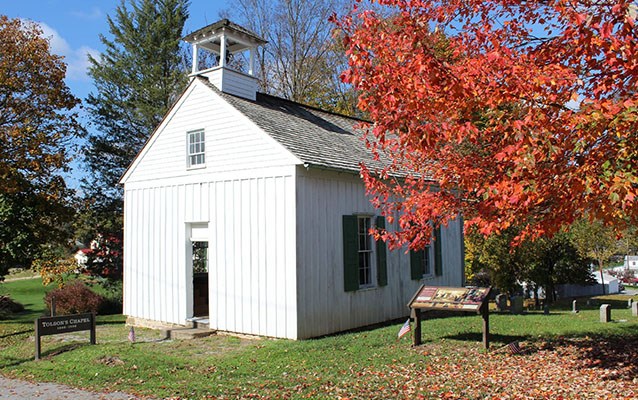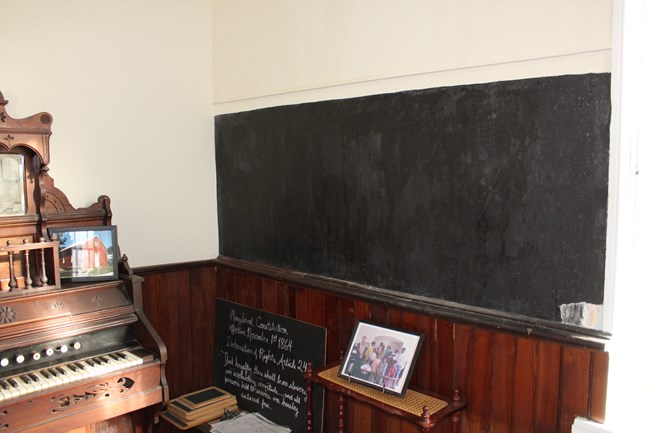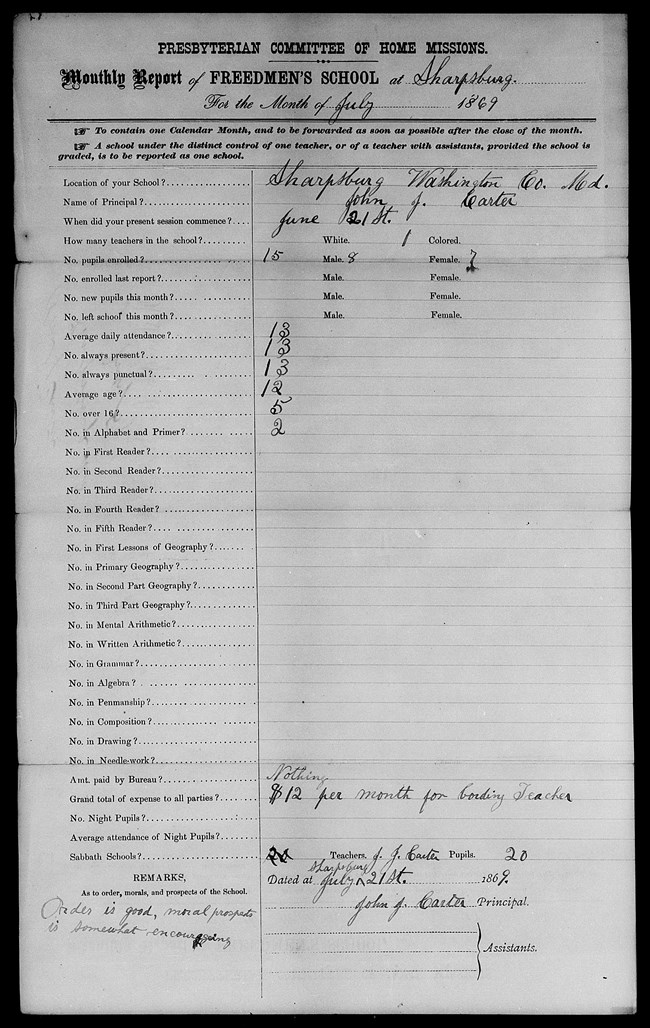Last updated: August 8, 2023
Article
African Americans and Education During Reconstruction: The Tolson’s Chapel Schools

In Sharpsburg, Maryland, a small church known as Tolson’s Chapel was at the center of local blacks’ efforts to educate themselves and their children. African American Methodists built Tolson’s Chapel in 1866, just two years after the end of slavery in Maryland in 1864. For much of the period between 1868 and 1899, this modest building near the site of the Civil War Battle of Antietam served as both a church and a school. The history of the schools housed in Tolson’s Chapel illustrates how African Americans across the former slave-holding states created and sustained schools during Reconstruction.
African American Education in Sharpsburg, 1864-1869
As African Americans built lives as free people in a free society during Reconstruction, they eagerly sought opportunities to learn. Before Emancipation, whites generally denied or restricted African Americans’ access to education in an effort to justify and maintain slavery. Learning to read therefore became a symbol of freedom for African Americans in the former slave-holding states. African Americans had other reasons for making literacy a priority after slavery ended. Many hoped that education would improve their economic circumstances and offer some protection from fraud and exploitation. They also saw education as important preparation for participating in civic life.African Americans faced significant challenges in their efforts to create schools during Reconstruction. One problem was a shortage of qualified teachers. In the early years of Reconstruction, local African Americans who could already read and write shared their knowledge with family, friends, and neighbors. In Sharpsburg, Maryland, for instance, David B. Simons, a literate African American and trustee of Tolson’s Chapel, likely taught some children and adults in the town in the mid-1860s. However, given the small number of literate African Americans in most communities in the former slave-holding states, there were not enough local teachers to meet the demand. In addition, black communities often struggled to afford to pay a teacher’s salary.
In hopes of getting financial assistance and more qualified teachers, African Americans in Sharpsburg and many other communities turned to the federal government’s Bureau of Refugees, Freedmen, and Abandoned Lands. Established by Congress in March 1865 , this agency was commonly known as the Freedmen’s Bureau. Since the underfunded Bureau had limited money and staff to devote to building schools, it worked with Northern benevolent organizations and African American communities to place Northern teachers in freedpeople’s schools in the Southern and border states. Northern benevolent organizations such as the American Missionary Society and the American Freedmen’s Union Commission recruited and paid teachers. The Freedmen’s Bureau then assigned the teachers to schools and provided them with transportation. The local African American community typically contributed room and board for the teacher as well as a building to house the school.
Thanks to the enthusiasm and persistence of the black community in Sharpsburg, the Freedmen’s Bureau twice assigned a teacher to this small town in western Maryland. In April 1868, the Freedmen’s Bureau sent Ezra Johnson, a white man from Pennsylvania, to Sharpsburg to teach. Johnson opened what he called the American Union School with limited financial assistance from Northern benefactors. John J. Carter, a black man, came to Sharpsburg to teach in the summer of 1869. The Presbyterian Home Mission paid his salary. African Americans in Sharpsburg provided room and board for both men.

NPS
Finding a building to use as a schoolhouse was often a challenge since few local whites were willing to sell or rent property to African Americans to use as schools. For many communities, including Sharpsburg, the solution was to use African American churches. African American congregations owned these buildings and, unlike most white landowners, were usually willing to support the schools. Ezra Johnson and John J. Carter held classes in Tolson’s Chapel, a church constructed by black Methodists in Sharpsburg in 1866. To outfit the building for use as a school, local residents applied liquid slate to the side walls of the church to create chalkboards.

National Archives and Records Administration
Despite the sacrifices required to send children to school, African American children filled schoolhouses in the Southern and border states during Reconstruction. In 1868 and 1869, at least twenty-five students attended school in Tolson’s Chapel. This number includes twelve children who had been born into slavery. Adults sought education as well. Ezra Johnson held night classes, and in the fall of 1869, local resident Samuel Ferguson reported that twenty-six men were ready to attend school during the winter when there was less work available.
Like most white teachers from the North, Ezra Johnson taught in African American schools for only a short time. He left Sharpsburg after just one term, having taught in freedpeople’s schools for less than a year. Johnson’s departure from teaching in May 1868 reflects a general decrease in the number of white teachers in the 1860s as their enthusiasm for the cause of freedpeople’s education waned. In contrast, black teachers from the North typically had a steadfast commitment to helping their fellow African Americans reach the goal of equality through education. Consequently, they were more likely to teach in the former slave-holding states for extended periods of time. Carter, for instance, taught in Sharpsburg for only one term, but went on to teach in an African American school in Virginia for nearly two decades.
The Freedmen’s Bureau ended its support for schools in 1870, just as Sharpsburg residents were writing to the Bureau in hopes of getting a third teacher. Although more than one thousand Northerners traveled south to teach freedpeople, most African American communities in the former slave-holding states never saw a teacher from the North. Many that did, like Sharpsburg, had teachers for only one or two terms at a time. As a result, most teachers in freedpeople’s schools were local African Americans. However, as was the case in Sharpsburg, their work often went unrecorded.
African Americans and Public Education, 1870-1899
By the fall of 1872, African American children in Sharpsburg were attending a racially segregated public school in Tolson’s Chapel. The establishment of public schools in the former slave-holding states owed much to African Americans’ commitment to education. In the former Confederate states, African Americans used their power as voters and legislators to create the frameworks for public education during the late 1860s and 1870s. Maryland, which did not join the Confederacy, established a public school system in 1864, before African American men in the state could vote. However, most counties did not operate an equal number of schools for African Americans until after the Fifteenth Amendment (1870) granted black men in Maryland the right to vote. Hoping to attract African American voters who placed a high priority on education, Republicans in the state legislature passed a law in 1872 that required a public school for African Americans in each district. That law led directly to the public school for African Americans that operated in Tolson’s Chapel from the early 1870s until 1899, when the county finally built a separate schoolhouse for African American children in Sharpsburg.
By establishing their own schools and advocating for public education, African Americans claimed education as one of their rights as citizens. Their dedication to that right laid the foundation for public schools for blacks and whites in the Southern and border states. As the home of a Freedmen’s Bureau school in the late 1860s and a public school starting in the 1870s, Tolson’s Chapel stands as a testament to the lasting importance of African Americans’ commitment to education during Reconstruction.
